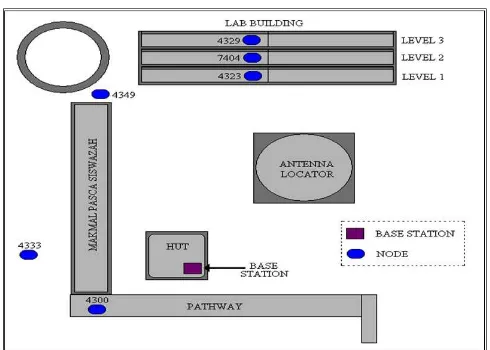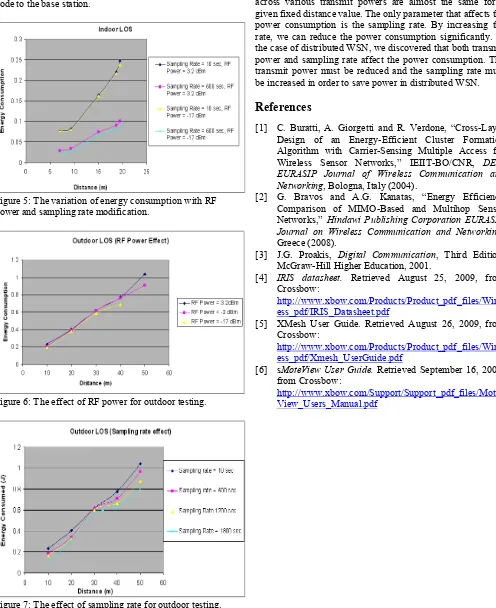A Study of Topology Characteristics on the Real Deployment of
Wireless Sensor Networks
M. Jaganathan, V. R. Krishnan, M. S. Zakaria, M. R. Ahmad
Faculty of Electronics and Computer Engineering (FKEKK), Universiti Teknikal Malaysia Melaka (UTeM) Hang Tuah Jaya, 76109 Durian Tunggal, Melaka, Malaysia
Keywords: centralized topology, distributed topology, wireless sensor network, real deployment.
Abstract
This paper investigates the effects of three parameters on the power consumption of sensor motes namely transmit power, frequency channel and sampling rate. Two wireless sensor network (WSN) test-beds have been deployed with two different types of topology; distributed and centralized. The WSN test-beds are built by using Crossbow IRIS motes where the effects of both real indoor and outdoor environment are investigated. Two different scenarios are considered which are line of sight (LOS) and non-LOS for both scenarios. In the case of centralized WSN with star topology, we discovered an interesting finding that the various transmit powers (ranging from 3.2dBm to -17dBm) do not vary the consumed power or in other word, the consumed powers across various transmit powers are almost the same for a given fixed distance value. The only parameter that affects the power consumption is the sampling rate. By increasing the rate, we can reduce the power consumption significantly. In the case of distributed WSN, we discovered that both transmit power and sampling rate affect the power consumption. The transmit power must be reduced and the sampling rate must be increased in order to save power in distributed WSN.
1 Introduction
Most of the work in optimizing the energy consumption of wireless sensor networks is focusing on the improvement of the existing protocols such as medium access control protocol and routing protocol for various topology configurations [1, 2]. Commonly the work done by simulation and the effects of the real propagation channel on various topology configurations are neglected. Researchers are tending to use the simplest channel model [3], which actually does not reflect the real deployment scenarios.
In this paper, we study the effects of the real channel propagation through real deployment on two kinds of topology: distributed and centralized. This paper investigates the effects of three parameters on the power consumption of sensor motes namely transmit power, frequency channel and sampling rate. Two wireless sensor network test-beds have been deployed with two different types of topology; distributed and centralized. The WSN test-beds are built by using Crossbow IRIS motes [4-6] where the effects of both
real indoor and outdoor environment are investigated. Two different scenarios are considered which are line of sight (LOS) and non-LOS for both scenarios.
2 Test-bed Deployment
2.1 Indoor Environment with Centralized Topology
Figure 1 shows that points where the sensor nodes and base station were placed for indoor environment with centralized topology. The test was carried out at the FKEKK Postgraduate Lab of UTeM. In order to form star topology the Line of Sight (LOS) is only suitable because if there is a blockage between the sensor node and the base station, the sensor node will automatically look for parent (nearest neighbour) node to transfer the data to base station. The sensor nodes were placed in various distance from the sensor node to observe also the effect of distance to the energy consumption. After collecting the measurement for certain time period, the data is exported to excel sheet to continue with the analysis process.
2.2 Outdoor Environment with Centralized Topology
Figure 2 shows the sensor node placed at the outdoor (UTeM football field) for centralized topology test-bed implementation. For outdoors the distance between each sensor node to the base station was set higher compared to indoor. For outdoor LOS is still preferred to avoid the sensor node to form mesh network topology. So the antenna of the sensor node was place face-to-face without any obstacles so that centralized topology is formed. The measurements were collected for a fix time interval for different modification of sensor node’s RF Power and sampling rate.
2.3 Distributed Topology
abolish the existing topology to form a new topology that could be a centralized topology.
This will be further affect the power consumption analysis which is the comparison between before and optimization process because the change of the transmission direction which will lead to the change of the change of topology will differ in terms of power consumption and break the analysis process. In order to that, maintaining the topology same from the starting point up to the ending point is very much important.
Figure 1: Indoor test-bed setup for centralized topology.
Figure 2: Outdoor test-bed setup for centralized topology.
Figure 3: Outdoor test-bed setup for distributed topology.
Figure 4: Indoor test-bed setup for distributed topology.
3 Results and Discussion
3.1 Indoor Environment
At first, the sensor nodes were tested with the default setting by Crossbow. The default settings are the Sampling Rate = 10 sec and the RF Power = 3.2 dBm. The energy consumption graph plotted is shown in Figure 5. Later on the sampling rate was modified to 600 sec (10 minutes) for each sensor node and the observation is there is a major drop in terms of energy consumption of the sensor node. At the maximum distance the energy consumed is dropped from 0.25 J to 0.1 J (dropped about 60%).
The second method is to analyze the effect of RF power to the energy consumption of the sensor node. If we observe the graph plotted the effect of changing the RF power is not that significant compare to changing the sampling rate. Even though, the RF power chosen was the minimum level (-17 dBm) but in the sense of energy consumption of sensor node there are no significant drop of energy observed. For star topology the RF power does not bring significant difference in terms of energy consumption.
Lastly, the most optimized method was used where the sampling rate = 10 minutes and the RF Power = -17 dBm. The graph obtained shows that the energy consumed is much lower than the other method.
3.2 Outdoor Environment
From Figure 6, the RF Power is varied from 3.2 dBm at first to -3 dBm and lastly to -17 dBm. The observation will be changing the RF power does not bring significant difference in terms of energy consumption of sensor node. Even when the RF power is -17 dBm the base station failed to detect the sensor node placed at a distance of 50 meters. So whether indoor or outdoor, the RF power does not bring significant difference in sense of energy consumption.
that significant compared to the graph obtained for Indoor analysis. So, for outdoor environment, the RF power and sampling rate does not bring much difference in terms of energy consumption due to the distance between the base station and sensor node is larger. Most of the energy consumed during transmitting the packet from the sensor node to the base station.
Figure 5: The variation of energy consumption with RF power and sampling rate modification.
Figure 6: The effect of RF power for outdoor testing.
Figure 7: The effect of sampling rate for outdoor testing.
4 Conclusion
In the case of centralized WSN with star topology, we have discovered an interesting finding that the various transmit powers (ranging from 3.2dBm to -17dBm) do not vary the consumed power or in other word, the consumed powers across various transmit powers are almost the same for a given fixed distance value. The only parameter that affects the power consumption is the sampling rate. By increasing the rate, we can reduce the power consumption significantly. In the case of distributed WSN, we discovered that both transmit power and sampling rate affect the power consumption. The transmit power must be reduced and the sampling rate must be increased in order to save power in distributed WSN.
References
[1] C. Buratti, A. Giorgetti and R. Verdone, “Cross-Layer Design of an Energy-Efficient Cluster Formation Algorithm with Carrier-Sensing Multiple Access for Wireless Sensor Networks,” IEIIT-BO/CNR, DEIS EURASIP Journal of Wireless Communication and Networking, Bologna, Italy (2004).
[2] G. Bravos and A.G. Kanatas, “Energy Efficiency Comparison of MIMO-Based and Multihop Sensor Networks,” Hindawi Publishing Corporation EURASIP Journal on Wireless Communication and Networking, Greece (2008).
[3] J.G. Proakis, Digital Communication, Third Edition, McGraw-Hill Higher Education, 2001.
[4] IRIS datasheet. Retrieved August 25, 2009, from Crossbow:
http://www.xbow.com/Products/Product_pdf_files/Wirel ess_pdf/IRIS_Datasheet.pdf
[5] XMesh User Guide. Retrieved August 26, 2009, from Crossbow:
http://www.xbow.com/Products/Product_pdf_files/Wirel ess_pdf/Xmesh_UserGuide.pdf
[6] sMoteView User Guide. Retrieved September 16, 2009, from Crossbow:

